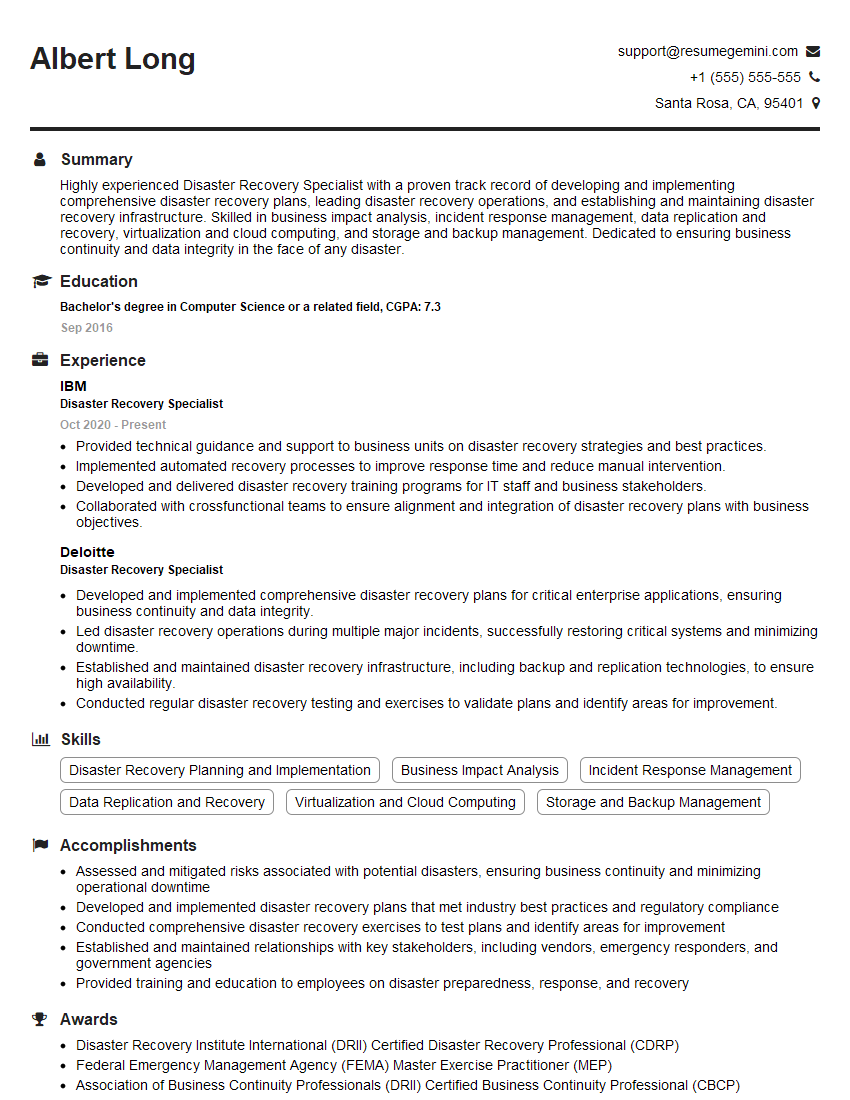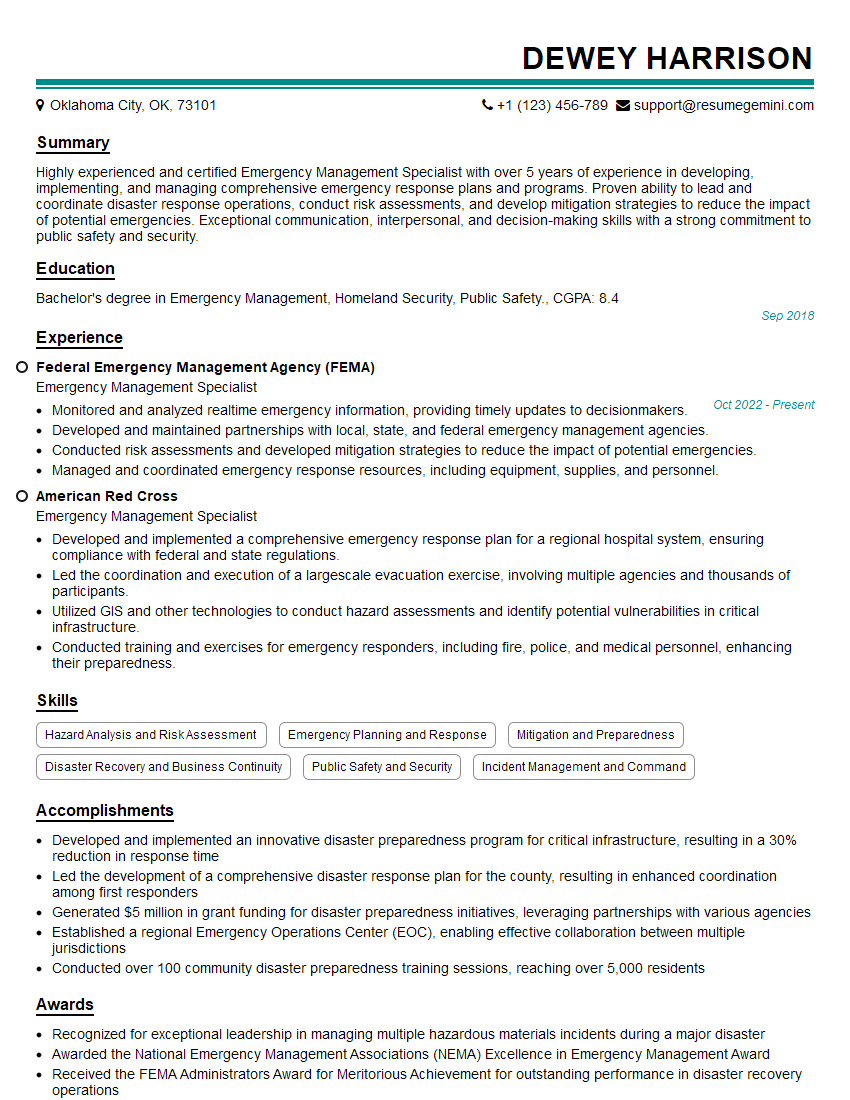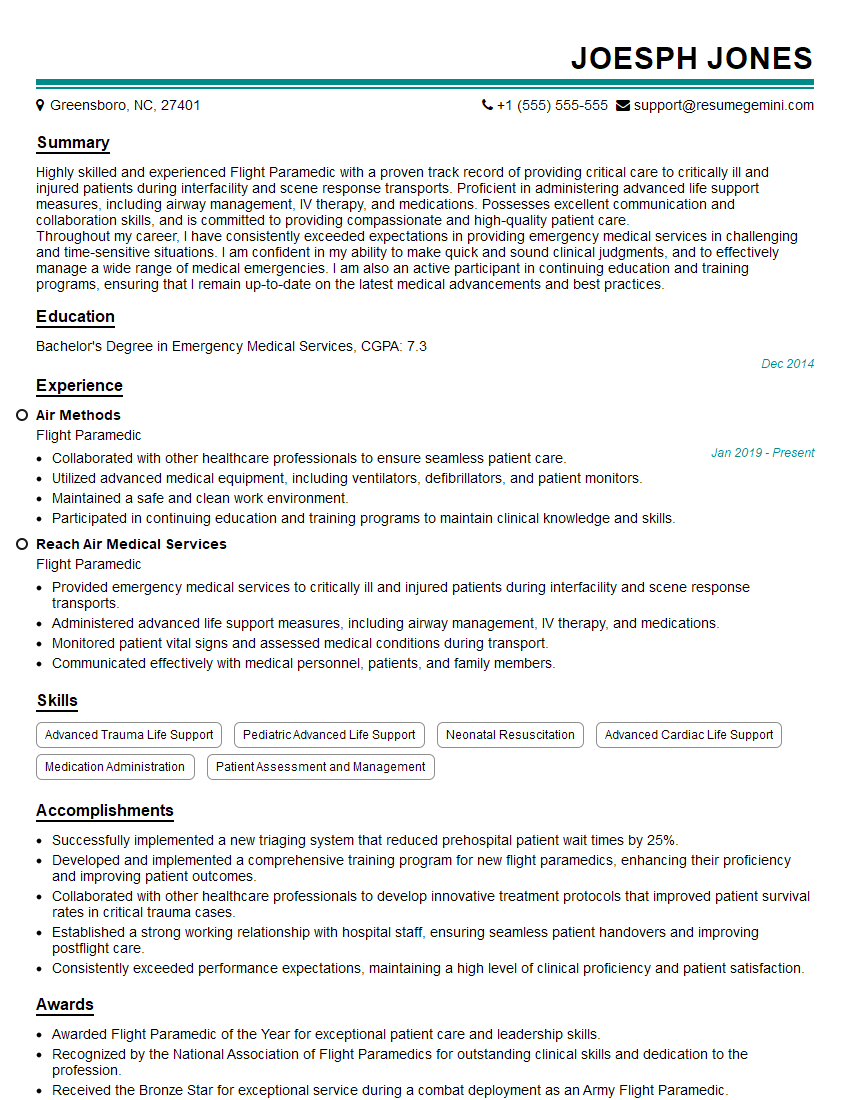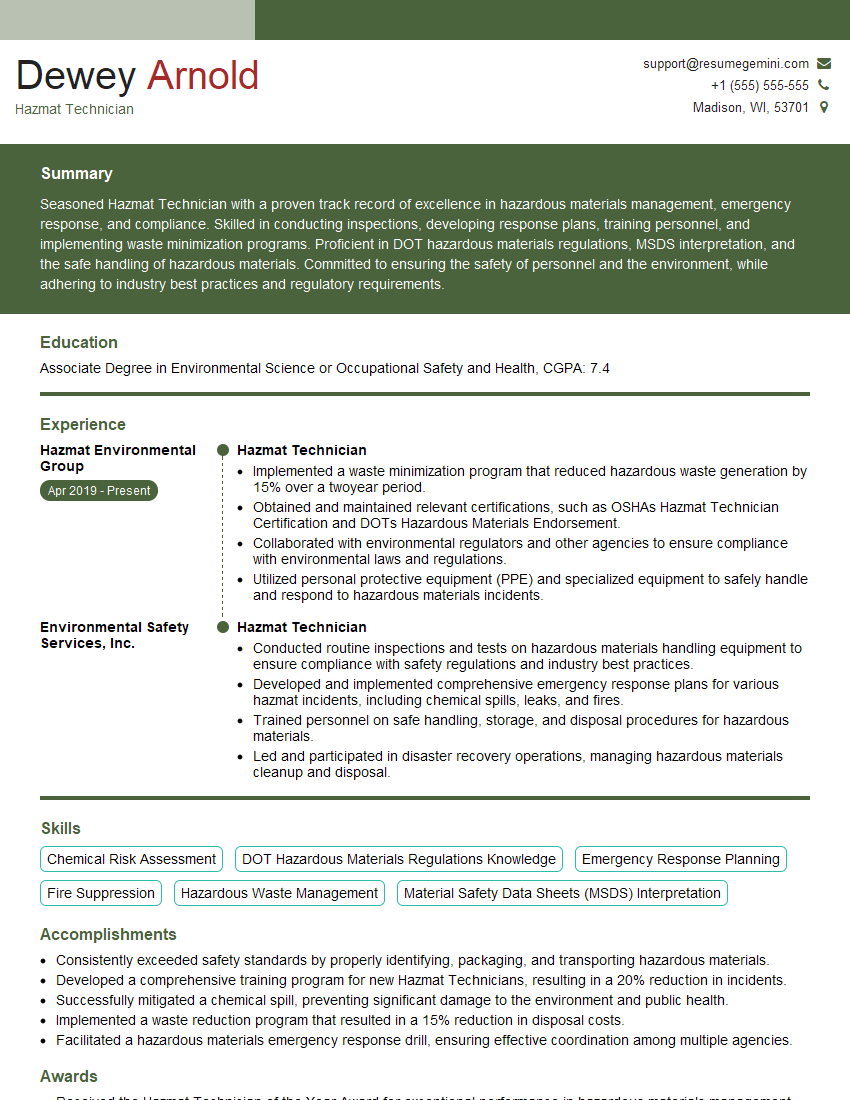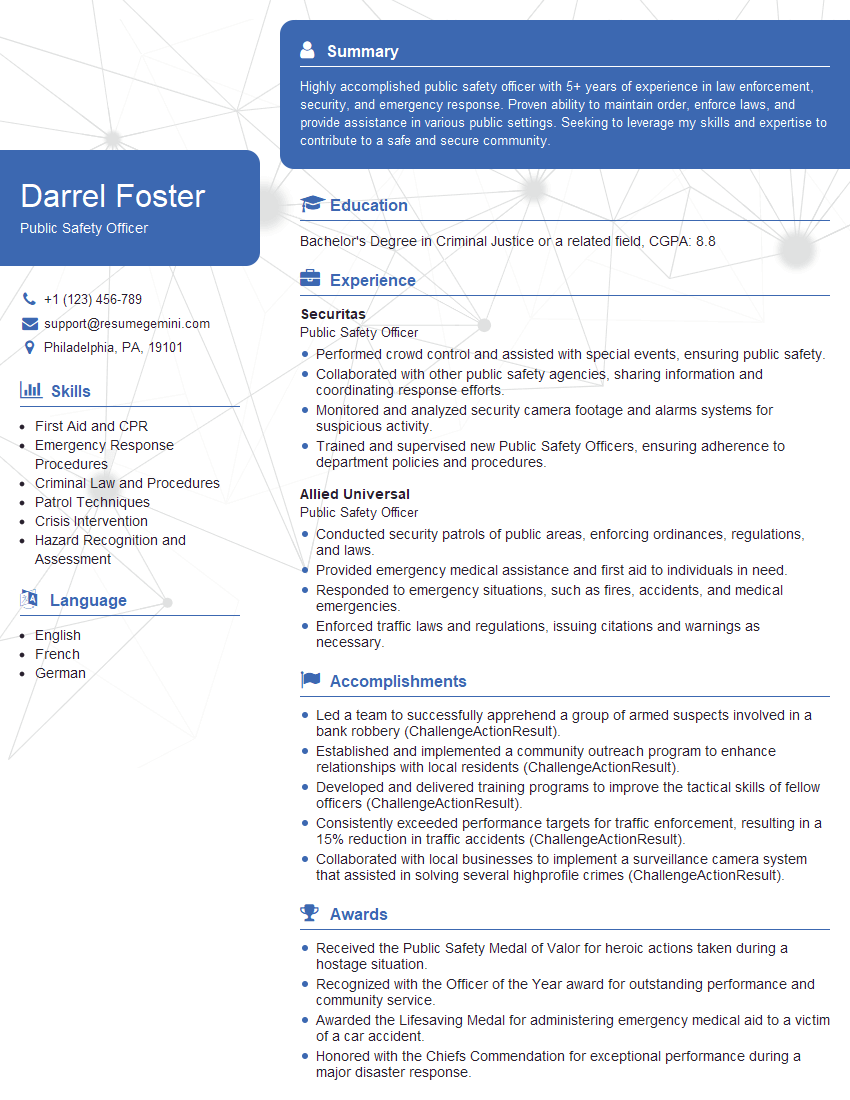Interviews are opportunities to demonstrate your expertise, and this guide is here to help you shine. Explore the essential Emergency Maneuvers interview questions that employers frequently ask, paired with strategies for crafting responses that set you apart from the competition.
Questions Asked in Emergency Maneuvers Interview
Q 1. Describe your experience with incident command systems.
My experience with Incident Command Systems (ICS) is extensive, spanning over 15 years in various emergency response roles. I’m proficient in all five ICS functional areas: Command, Operations, Planning, Logistics, and Finance/Administration. I’ve served in numerous capacities, from Unit Leader to Incident Commander, managing incidents ranging from localized hazardous material spills to large-scale natural disasters. For example, during a major wildfire, I led the Operations Section, coordinating resources, assigning tasks, and tracking progress across multiple strike teams. My understanding of ICS extends beyond simple application; I actively participate in exercises and training to refine my skills and remain abreast of best practices. This ensures seamless integration and effective communication across multiple agencies and jurisdictions during complex events. I’m also familiar with various ICS software applications used for resource tracking, communication, and data management.
Q 2. Explain the different types of emergency response plans.
Emergency response plans vary greatly depending on the potential hazard. They can be broadly categorized as follows:
- All-Hazards Plans: These are comprehensive plans designed to address a wide range of emergencies, from natural disasters (earthquakes, floods) to man-made incidents (chemical spills, terrorist attacks). They provide a flexible framework adaptable to various scenarios.
- Specific-Hazard Plans: These focus on a particular type of emergency, such as a hurricane evacuation plan or a wildfire response plan. They offer detailed procedures tailored to the specific threat.
- Facility-Specific Plans: These plans address emergencies within a particular location, like a hospital, school, or industrial facility. They outline evacuation routes, emergency contact information, and specific safety procedures.
- Community-Based Plans: These involve collaboration between local government, emergency services, and community organizations to coordinate response efforts. They often include public awareness campaigns and community preparedness initiatives.
The effectiveness of any plan hinges on regular review, testing, and updating to reflect changes in the environment and lessons learned from past incidents. For example, a community’s flood response plan should be updated after experiencing a major flood, incorporating lessons learned about evacuation routes, resource allocation, and shelter management.
Q 3. How would you prioritize multiple emergencies simultaneously?
Prioritizing multiple simultaneous emergencies requires a systematic approach using a triage system similar to medical triage. I use the following steps:
- Assess the Threat: Quickly determine the severity and potential impact of each incident (number of casualties, potential for escalation, environmental impact).
- Resource Availability: Evaluate the resources available to address each incident (personnel, equipment, supplies).
- Impact Analysis: Determine which incidents pose the greatest immediate threat to life, property, and the environment.
- Prioritize and Allocate: Assign resources to incidents based on their priority, starting with the most critical.
- Dynamic Re-evaluation: Continuously monitor the situation and adjust priorities as the situation evolves. This is crucial, as circumstances can change rapidly.
Imagine a scenario with a building fire, a traffic accident with multiple injuries, and a suspected hazardous material leak. Using this method, I’d likely prioritize the building fire due to the potential for loss of life and significant property damage, followed by the traffic accident, and then the hazardous material leak (once the extent of the threat is properly assessed). Communication and coordination are paramount in such scenarios to avoid resource conflicts and ensure effective overall response.
Q 4. What is your experience with risk assessment and mitigation?
Risk assessment and mitigation are integral parts of my emergency management approach. I’m experienced in conducting thorough risk assessments, identifying vulnerabilities, and developing mitigation strategies to minimize potential impacts. This involves analyzing historical data, performing site surveys, and considering various scenarios (e.g., ‘what if’ analysis). I use various frameworks, including HAZOP (Hazard and Operability Study) and FMEA (Failure Mode and Effects Analysis), to systematically identify potential hazards and their consequences. For example, in assessing the risk of a wildfire, I would consider factors like fuel load, weather conditions, proximity to populated areas, and the availability of firefighting resources. Based on this assessment, mitigation strategies might include controlled burns, community education, and the development of evacuation plans.
Q 5. Describe your experience with emergency communication protocols.
My experience with emergency communication protocols encompasses a wide range of technologies and methods. I’m proficient in using radios (conventional and digital), satellite phones, text messaging systems, and emergency alert systems. I understand the importance of clear, concise, and timely communication to ensure everyone involved is informed and working from the same information. I have experience establishing and managing communication channels during large-scale incidents, including setting up mobile command centers and coordinating communications between multiple agencies. I’m also familiar with various communication protocols, like the Incident Command System (ICS) communication plan, and understand how to effectively use these methods to streamline information flow.
Q 6. How do you maintain situational awareness during a crisis?
Maintaining situational awareness during a crisis is crucial for effective decision-making. I employ a multi-faceted approach that includes:
- Constant Monitoring: Continuously receiving and processing information from various sources (reports from field teams, weather updates, intelligence reports).
- Map-Based Visualization: Using real-time mapping systems to track the incident’s progress and resource deployment.
- Data Analysis: Analyzing data to identify trends and predict potential challenges.
- Regular Briefings: Conducting regular briefings with team members to share information and updates.
- Collaboration: Seeking input from diverse perspectives to gain a holistic understanding of the situation.
Imagine a hurricane response. Maintaining situational awareness means constantly tracking the storm’s path, monitoring water levels, and staying informed about evacuations and damage reports. It requires being proactive and adaptable to changing information and remaining calm under pressure to avoid tunnel vision and misinterpretations.
Q 7. Explain your approach to decision-making under pressure.
My approach to decision-making under pressure is guided by a structured yet flexible framework. I prioritize:
- Information Gathering: Obtaining as much accurate information as possible, even if it’s incomplete.
- Risk Assessment: Evaluating the potential consequences of each course of action.
- Collaboration: Seeking input from trusted colleagues and experts.
- Time Sensitivity: Recognizing the urgency of the situation and making timely decisions even with limited information.
- Adaptation: Remaining flexible and adjusting my approach based on evolving circumstances.
I avoid impulsive decisions and instead favor a balanced approach combining decisive action with calculated risk. I also recognize the importance of post-incident analysis to learn from both successes and failures, constantly refining my decision-making process. My experience has taught me that the best decisions often involve a combination of swift action and considered judgment.
Q 8. How would you handle a conflict between different agencies during a response?
Inter-agency conflict during emergencies is unfortunately common, stemming from differing priorities, communication breakdowns, and jurisdictional overlaps. Effective conflict resolution hinges on establishing clear command structures, fostering open communication, and prioritizing a unified response.
My approach begins with pre-planning: participating in joint exercises and establishing clear protocols for communication and decision-making. During an actual event, I utilize a collaborative, problem-solving approach. This involves actively listening to all parties involved, identifying the root cause of the conflict (e.g., resource limitations, differing risk assessments), and facilitating a discussion to find mutually acceptable solutions. For instance, in a wildfire response, a conflict might arise between a fire suppression agency prioritizing containment and a public health agency prioritizing evacuation. I would facilitate a meeting, potentially utilizing a structured decision-making tool, to weigh the risks and benefits of each approach and collaboratively develop a plan integrating both objectives.
Ultimately, success depends on building trust and mutual respect among agencies before an emergency hits. Regular joint training, shared information platforms, and a culture of collaboration are essential to mitigating future conflicts.
Q 9. Describe your experience with resource allocation during an emergency.
Resource allocation during emergencies is a critical and often high-pressure task. It requires a combination of strategic thinking, real-time assessment, and decisive action. My experience involves working within Incident Command Systems (ICS), a standardized management system widely used for emergency response. ICS provides a structured framework for prioritizing needs and assigning resources effectively.
In a recent flood event, I was responsible for allocating rescue teams, boats, and medical personnel. Utilizing real-time data feeds, such as aerial imagery and emergency calls, we prioritized locations with the most immediate and severe needs. A critical aspect was balancing immediate life-saving actions with the need to address broader long-term issues like shelter and medical support for displaced persons. This involved complex trade-offs and required constant reevaluation. For example, diverting resources from a less critical area to a newly discovered pocket of trapped residents required tough decisions and clear communication.
Effective resource allocation also involves anticipating future needs. Proactive planning, including pre-positioned resources and established supply chains, are vital to minimize response time and maximize efficiency.
Q 10. How do you debrief after an emergency event?
Debriefing after an emergency is crucial for identifying areas for improvement and preventing future errors. It’s not just about assigning blame, but about fostering a learning environment.
My approach to debriefing involves a structured process. We gather all involved personnel – from first responders to support staff – to discuss the event in a safe and non-judgmental space. We use a structured format, often incorporating a timeline of events, to analyze the response in phases: preparation, response, and recovery. We discuss what went well, what could have been improved, and why. This often involves reviewing communication logs, resource allocation records, and other documentation. We document lessons learned and develop actionable improvement plans. For example, after a hospital evacuation drill, a debrief might reveal communication delays hindering the movement of patients. This leads to implementation of a new communication system for future scenarios.
The goal is to create a culture of continuous learning and improvement. Regular debriefs enhance team cohesion and ensure future preparedness.
Q 11. What is your experience with evacuation procedures?
Evacuation procedures are a critical component of emergency management, requiring careful planning and effective execution. My experience involves planning and executing evacuations for various hazards, including wildfires, floods, and hazardous material spills.
This involves understanding the geographic area, identifying vulnerable populations, and developing multiple routes and shelters. We utilize a phased approach, prioritizing high-risk areas and communicating effectively with the public through various channels, such as emergency alerts, social media, and community outreach. This also includes considering accessibility needs for individuals with disabilities, ensuring the availability of transportation, and establishing robust communication systems during the evacuation. For instance, in a wildfire evacuation, we would coordinate with transportation agencies to ensure the availability of buses and other vehicles. During a large-scale evacuation, coordinating with neighboring jurisdictions for mutual aid and resource sharing may be vital. Post-evacuation, we’d assess the effectiveness of the procedures and make adjustments for future events.
Safe and efficient evacuations require meticulous planning, clear communication, and a well-coordinated team effort.
Q 12. Explain your understanding of different hazard types (e.g., natural, man-made).
Hazards are broadly categorized into natural and man-made. Natural hazards include events like earthquakes, hurricanes, floods, wildfires, and landslides—occurring due to natural processes. Man-made hazards encompass events caused by human actions, such as industrial accidents, terrorist attacks, and chemical spills.
Understanding these distinctions is crucial for developing appropriate mitigation and response strategies. Natural hazards often require a focus on prediction, early warning systems, and community preparedness, while man-made hazards require stringent regulatory oversight, improved safety procedures, and robust emergency response protocols. Both categories demand a multi-disciplinary approach, requiring collaboration between diverse professionals and agencies. For example, a chemical spill will demand expertise from environmental agencies, public health officials, and emergency medical services, while a hurricane requires coordination between meteorological agencies, emergency management, and search and rescue teams.
My experience spans diverse hazards, equipping me with the adaptability to address the unique challenges of each event.
Q 13. How would you manage public information during an emergency?
Managing public information during an emergency is paramount for ensuring public safety and minimizing panic. It requires a multi-faceted approach emphasizing transparency, accuracy, and consistency.
My approach involves establishing a dedicated communications team responsible for disseminating information through various channels, including social media, local news outlets, emergency alert systems, and community radio. Information must be clear, concise, and accessible to diverse audiences, considering language barriers and literacy levels. We prioritize providing timely and accurate updates on the situation, evacuation orders, shelter locations, and health advisories. For instance, during a pandemic, we would deploy social media campaigns offering clear guidance on safety measures, testing locations, and vaccination programs. To ensure consistency, we use pre-approved messaging to prevent the spread of misinformation and rumors. Addressing public concerns promptly and directly is crucial to maintain trust and confidence in the emergency response.
Effective public information management fosters community resilience and promotes a safe and efficient response.
Q 14. Describe your experience with post-incident analysis and improvement plans.
Post-incident analysis and improvement planning are fundamental to enhancing future preparedness and response effectiveness. It involves a comprehensive review of the entire emergency response cycle, from preparedness to recovery.
My experience includes conducting detailed post-incident analyses, often leveraging established frameworks like the After-Action Report (AAR) method. This involves gathering data from various sources – incident reports, communication logs, interviews, and post-event surveys – to thoroughly assess the effectiveness of the response. We identify strengths and weaknesses, analyze contributing factors to successes and failures, and establish clear recommendations for improvement. For example, a post-incident analysis might reveal shortcomings in communication coordination between agencies resulting in delayed resource deployment. This would lead to concrete recommendations, such as establishing a unified communications system and strengthening inter-agency collaboration protocols.
The ultimate goal is to create a continuous improvement cycle, incorporating lessons learned to enhance future emergency preparedness and response capabilities. This ensures the community is better equipped to handle future incidents.
Q 15. What safety measures do you employ during emergency response?
Safety during emergency response is paramount. It’s a layered approach, starting with personal protective equipment (PPE). This includes high-visibility clothing, helmets, gloves, and appropriate footwear depending on the situation. Scene safety is equally crucial. We always assess the immediate environment for hazards like downed power lines, unstable structures, or hazardous materials before entering. This often involves establishing a perimeter and coordinating with other emergency services to ensure a safe working zone. We also follow established protocols for communication, using clear radio procedures and maintaining situational awareness at all times. For example, during a vehicle extrication, we would first secure the scene, stabilize the vehicle, and then use specialized tools to safely remove the occupant, prioritizing their well-being and avoiding further injury.
Career Expert Tips:
- Ace those interviews! Prepare effectively by reviewing the Top 50 Most Common Interview Questions on ResumeGemini.
- Navigate your job search with confidence! Explore a wide range of Career Tips on ResumeGemini. Learn about common challenges and recommendations to overcome them.
- Craft the perfect resume! Master the Art of Resume Writing with ResumeGemini’s guide. Showcase your unique qualifications and achievements effectively.
- Don’t miss out on holiday savings! Build your dream resume with ResumeGemini’s ATS optimized templates.
Q 16. How do you ensure the safety of your team during an emergency?
Team safety relies on strong leadership, clear communication, and adherence to established protocols. Before any deployment, we conduct a thorough risk assessment, identifying potential dangers and outlining mitigation strategies. This might involve assigning specific roles and responsibilities, establishing clear communication channels, and briefing the team on the specific hazards present. During operations, we maintain constant communication, using buddy systems to ensure no one is isolated. Regular check-ins and clear hand signals are crucial, especially in noisy or chaotic environments. For instance, during a search and rescue operation in a collapsed building, we would use designated communication channels, pre-determined meeting points, and rope systems for safety and to avoid getting lost.
Post-incident debriefs are also vital for improving team safety and identifying areas for improvement. We analyze the response, highlighting both successes and areas where procedures could be strengthened. This continuous learning approach is essential for maintaining a safe and effective team.
Q 17. Describe your experience with mass casualty incidents (MCI).
My experience with Mass Casualty Incidents (MCIs) includes responding to a large-scale train derailment. The sheer volume of patients required immediate and efficient triage, resource allocation, and coordination with multiple agencies. We utilized the START triage system (Simple Triage And Rapid Treatment) to rapidly assess patients and prioritize those with the most life-threatening injuries. This involved assigning patients to different categories based on their respiratory status, perfusion, and mental status. Effective communication with hospitals and other emergency services was critical to ensure timely transport and treatment. This experience highlighted the importance of pre-planning, standardized procedures, and robust communication networks during MCIs. The collaborative efforts of different agencies, from paramedics and fire fighters to law enforcement and hospital staff, was instrumental in managing the situation effectively. The experience underscored the necessity for training and practice in managing MCI’s to ensure effectiveness in such high-pressure scenarios.
Q 18. How would you utilize available technology during an emergency response?
Technology plays a vital role in modern emergency response. We utilize GPS tracking systems to monitor the location of responders and resources, improving situational awareness and coordination. Mobile data terminals (MDTs) in emergency vehicles allow real-time access to patient records, incident information, and maps. Body-worn cameras provide valuable documentation and enhance accountability. Drones can be deployed for aerial reconnaissance in hazardous or inaccessible areas, providing valuable visual information to incident commanders. In a recent flooding incident, we used drone footage to assess the extent of the damage and locate trapped individuals, significantly improving our response time and efficiency. Furthermore, applications that allow for real-time information sharing among responders, such as group chat and mapping applications, are increasingly integral to effective emergency response.
Q 19. What is your experience with training and development in emergency response?
My training in emergency response is ongoing and extensive. It includes advanced certifications in emergency medical techniques, hazardous materials handling, and urban search and rescue. Regular refresher courses and continuing education are crucial to maintain proficiency and stay updated on best practices. I also participate in simulation exercises that replicate real-world emergency scenarios, allowing us to practice teamwork, refine techniques, and identify potential weaknesses in our procedures. These exercises often involve mass casualty simulations, high angle rescues, and confined space rescues, which are invaluable for maintaining a high level of preparedness for diverse emergency situations. I also actively participate in training and mentoring new team members.
Q 20. How would you handle an unexpected complication during an emergency?
Handling unexpected complications requires a calm and systematic approach. The first step is to immediately assess the situation, identifying the nature of the complication and its potential impact. Next, we re-evaluate the existing plan, adapting strategies as necessary. This might involve requesting additional resources, modifying the approach, or implementing contingency plans. Open communication with the team is crucial, ensuring everyone is aware of the change in circumstances and their new roles. For example, if during a vehicle extrication, we discover unexpected structural instability, we would immediately halt the process, re-assess the risk, and possibly call in structural engineers to support the process safely. Thorough documentation of the complication, the response, and the outcome helps in future learning and prevents repeated mistakes.
Q 21. Describe your experience with working under stressful conditions.
Working under stressful conditions is an inherent part of emergency response. Through years of experience, I’ve developed strategies to manage stress effectively. This includes maintaining a strong physical fitness routine and prioritizing sleep. Focusing on the task at hand, rather than dwelling on the pressure, helps maintain clarity and focus. Developing a robust support network, comprised of colleagues and family, is equally crucial for emotional well-being. Regular debriefing sessions, both formal and informal, allow us to process the emotional toll of difficult incidents. This is crucial for preventing burnout and maintaining mental resilience. Utilizing established stress-reduction techniques such as mindfulness and breathing exercises also improves preparedness and effectiveness under pressure. I firmly believe in the importance of maintaining a healthy work-life balance, as this enhances both performance and overall well-being.
Q 22. How do you maintain your composure during high-pressure situations?
Maintaining composure under pressure is paramount in emergency response. It’s about managing stress and anxiety to make rational, effective decisions. My approach is multifaceted. Firstly, I prioritize thorough training and preparation. Knowing protocols and procedures beforehand significantly reduces uncertainty and panic. Secondly, I utilize deep breathing exercises and mindfulness techniques to center myself. This helps regulate my physiological response to stress. Finally, I rely on effective communication and teamwork. Clearly communicating needs and delegating tasks efficiently keeps the situation organized and reduces individual stress levels. Think of it like a conductor of an orchestra – even in a chaotic piece, clear direction ensures a cohesive performance. In practice, this means focusing on immediate priorities, breaking down complex tasks into smaller, manageable steps, and remembering that even under immense pressure, methodical execution will increase the chances of a successful outcome.
Q 23. Explain your understanding of legal liabilities in emergency response.
Legal liabilities in emergency response are complex and vary by jurisdiction. Generally, responders must act within the scope of their training and authority, adhering to established protocols and best practices. Negligence, defined as a failure to exercise reasonable care, is a primary area of legal concern. This means failing to perform duties to a standard expected of a reasonably competent professional in similar circumstances. For example, improperly using equipment, disregarding safety protocols, or not providing appropriate care could lead to legal repercussions. Additionally, there are considerations surrounding informed consent, particularly in medical emergencies. Documentation is critical; thorough record-keeping provides evidence of actions taken, protecting both the responder and the individual(s) being assisted. Finally, compliance with relevant laws, regulations, and agency policies is crucial to mitigating potential liability.
Q 24. What is your experience with different types of personal protective equipment (PPE)?
My experience with PPE is extensive, encompassing various types used in diverse emergency scenarios. This includes:
- Level A suits: Fully encapsulating suits for hazardous materials incidents, providing maximum protection against chemical, biological, radiological, and nuclear (CBRN) threats.
- Level B suits: Similar to Level A but with less respiratory protection, offering a balance between protection and mobility.
- Level C suits: Air-purifying respirators with protective clothing, suitable for environments with known hazards.
- Level D suits: Standard work uniforms with minimal protection, suitable only for low-risk situations.
- Specialized PPE: Eye protection, gloves, boots, helmets, and self-contained breathing apparatus (SCBA) are regularly used, sometimes in combination, depending on the situation.
I am proficient in selecting, donning, doffing, and maintaining all these PPE types, understanding the limitations of each and their correct application in different situations. For example, I know that a Level A suit is essential when dealing with a highly toxic chemical spill, while a Level D suit may suffice for a minor traffic accident.
Q 25. How do you assess the effectiveness of an emergency response plan?
Assessing the effectiveness of an emergency response plan involves a multi-faceted approach, combining pre- and post-incident evaluations. Pre-incident evaluations involve regular drills and exercises, table-top simulations, and walkthroughs to identify weaknesses in the plan’s design and execution. This allows for adjustments and improvements before an actual emergency occurs. Post-incident evaluations, conducted after an actual event, involve a comprehensive review of the response. This includes analyzing communication effectiveness, resource allocation, coordination among responders, and overall outcomes. Key metrics include response times, incident containment efficiency, number of casualties, and damage assessment. Debriefings with involved personnel provide crucial feedback for identifying areas needing improvement. The use of After-Action Reports (AARs) is vital, providing a structured framework for documenting the entire process, including successes, failures, and recommendations for future improvements.
Q 26. Describe a time you had to make a difficult decision under pressure during an emergency.
During a major building fire, I had to make a difficult decision regarding resource allocation. We had limited personnel and equipment, with multiple trapped individuals on different floors. Initial reports indicated a higher number of trapped people on the second floor, but a faint cry for help was heard from the third. Allocating all resources to the second floor seemed logical due to the higher casualty count. However, ignoring the cry for help from the third floor was unacceptable. I decided to split our resources, sending a smaller team to the third floor while prioritizing the second. This was a high-stakes gamble, as it stretched our resources thin. Ultimately, the decision proved effective. Both teams successfully rescued the trapped individuals, minimizing casualties. This experience highlighted the importance of swift, data-driven, yet compassionate decision-making, even when faced with limited resources.
Q 27. How familiar are you with the National Incident Management System (NIMS)?
I am very familiar with the National Incident Management System (NIMS). I understand its core principles – preparedness, communication, resource management, and command and control – and how they are implemented across various agencies and jurisdictions. NIMS provides a standardized framework for managing all types of incidents, from natural disasters to terrorist attacks. My understanding extends to the various components of NIMS, including the Incident Command System (ICS), which provides a structured organizational framework for managing an incident. I am proficient in applying ICS principles in diverse situations, adapting my approach to the specific needs of each incident. This understanding enables effective communication and collaboration with multiple agencies and personnel during large-scale emergencies. I regularly participate in exercises and training that reinforce my NIMS proficiency and ensure I stay current with best practices.
Q 28. What are your strengths and weaknesses when it comes to emergency response?
My strengths include excellent decision-making under pressure, strong leadership skills, and a comprehensive understanding of emergency response protocols. I am a highly effective communicator, able to convey complex information clearly and concisely to diverse audiences. My experience with diverse emergency scenarios enables me to adapt quickly to changing circumstances. However, I am continually striving to improve. While I am comfortable delegating tasks, I sometimes find it challenging to relinquish control completely, which I am actively working to overcome through self-reflection and mentorship. By continually seeking feedback and participating in professional development opportunities, I aim to mitigate this weakness and strengthen my overall leadership capabilities.
Key Topics to Learn for Emergency Maneuvers Interview
- Risk Assessment and Mitigation: Understanding how to identify potential hazards and implement preventative measures before, during, and after an emergency.
- Emergency Response Procedures: Knowing and applying established protocols for various emergency scenarios, including incident command systems and communication strategies.
- Emergency Vehicle Operation: Demonstrating proficiency in safe and effective driving techniques under pressure, including defensive driving and emergency vehicle maneuvers.
- First Aid and CPR: Highlighting your knowledge and practical skills in providing immediate medical assistance to injured individuals.
- Incident Management and Coordination: Explaining your experience in coordinating resources and personnel during emergency situations, focusing on effective communication and delegation.
- Post-Incident Analysis and Reporting: Demonstrating your ability to conduct thorough post-incident reviews, identifying areas for improvement and contributing to a culture of continuous learning.
- Legal and Ethical Considerations: Understanding the legal framework surrounding emergency response and maintaining ethical conduct in high-pressure environments.
- Technological Proficiency: Showcasing familiarity with relevant technologies used in emergency management, such as communication systems, GPS tracking, and data analysis tools.
- Teamwork and Leadership: Emphasizing your ability to collaborate effectively within a team, and to lead and motivate others during crisis situations.
Next Steps
Mastering Emergency Maneuvers is crucial for career advancement in this high-demand field. A strong understanding of these critical skills will set you apart from other candidates and open doors to exciting opportunities. To maximize your chances of landing your dream job, invest time in creating an ATS-friendly resume that showcases your skills and experience effectively. ResumeGemini is a trusted resource that can help you build a professional and impactful resume. They offer examples of resumes tailored to Emergency Maneuvers to provide you with the best possible template for success. Take the next step towards your career goals – build your best resume today.
Explore more articles
Users Rating of Our Blogs
Share Your Experience
We value your feedback! Please rate our content and share your thoughts (optional).
What Readers Say About Our Blog
Hi, I’m Jay, we have a few potential clients that are interested in your services, thought you might be a good fit. I’d love to talk about the details, when do you have time to talk?
Best,
Jay
Founder | CEO
